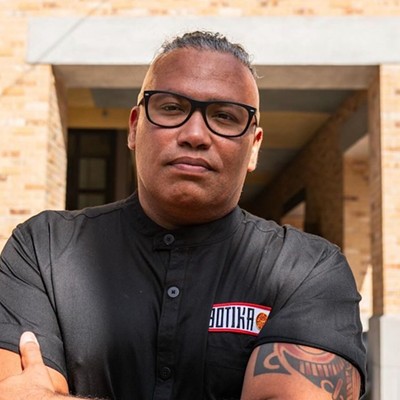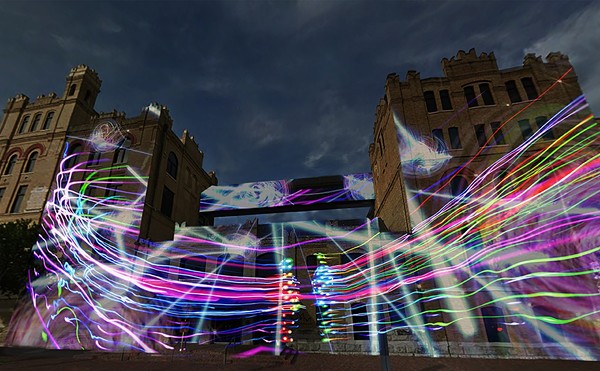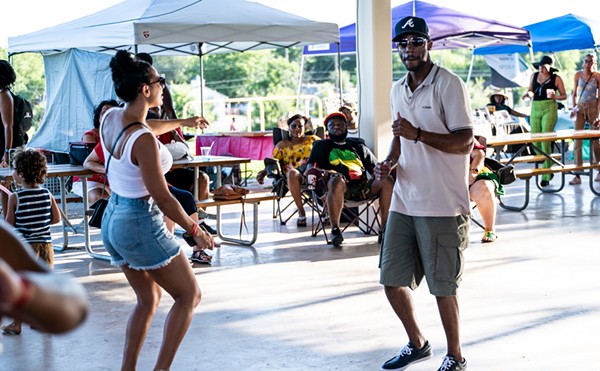From the Projects to the Runway: Rasquache-Inspired Designer Agosto Cuellar Takes His Next Leap
By Bryan Rindfuss on Thu, Aug 15, 2019 at 8:51 am
Sitting at a small desk in Beacon Hill’s Clamp Light Artist Studios and Gallery, beloved San Antonio creator Agosto Cuellar scans the sunlit room he’s decorated with the final relics of Jive Refried, the Southtown vintage emporium he ran from 1999 to 2011. Intentionally blurring boundaries between gallery and boutique, art installation and retail merchandising, the exhibition — curated by Clamp Light resident artist Sarah Castillo and simply titled “Jive Refried” — commemorates the bygone shop’s 20th anniversary.
Amid a visual memoir of oddly dressed mannequins, fashion photographs and reconfigured accessories, a placemat-sized panel covered in fake blue flowers catches his eye. Untacking it from the wall, he folds it in half and clutches it, modeling the item as if it’s a statement-making handbag. His purpose is to illustrate his lifelong love affair with rasquache — an artistic practice that involves celebrating, repurposing and transforming whatever materials might be at hand. An increasingly cited “underdog” aesthetic closely tied to Chicano art, rasquache is embedded in the cultural fabric of San Antonio — present in everything from mosaics fashioned from broken mirrors and shards of pottery to the mismatched, collage-like sensibility that informs yards and porches across the city.
“I’ve always been a thrifter for my art because it was affordable,” Cuellar says. “I was able to take stuff that was inexpensive and, in a very rasquache way, make something beautiful out of it.”
Cuellar’s earliest crafting skills were passed down from his grandmother, who taught him the basics of sewing.
“I was probably seven, maybe even younger, and I would help her with her dolls,” he says. “I have her sewing machine now. It’s funny that it’s kind of come full circle.”
In Cuellar’s eyes, rasquache is something of an inherited trait. “It goes back not just to my grandparents but also my ancestors — like tribes of back, back, back ancestors — who were creating things with whatever was available. And, so, I think I have that sensibility from the bloodlines. I don’t know, it’s just natural! Like, that was meant to be what? No, it was meant to be that!”
A proud West Side native, Cuellar grew up in the Mirasol Projects and vividly remembers views of an imposing cement wall ringed with barbed wire.
“I always wondered what was on the other side of that wall, [and] it was Our Lady of the Lake University,” he says. “It was interesting how that barrier created a lot of things in my mind. Like why are we being kept out of this place of higher learning? I was very inquisitive at as young age, and I wanted to see what my city had to offer.”
By Cuellar’s teenage years, his family had relocated to a ranch in Helotes and he was attending Marshall High School. While at Marshall, he got his first taste of fashion retail through a work-study program that led to jobs at trendy Ingram Park Mall stores — Judy’s, Le Shoe and a Merry-Go-Round offshoot among them. This was during the onset of the over-the-top ’80s. Music and fashion were becoming increasingly intertwined, and malls set the stage not just for shopping but gatherings of the alternative sets — gays, punks, new wavers, skaters and others who came to watch the social circus and be seen themselves.
“It was really cool,” Cuellar recalls. “Especially the people who would come in. They would be buying all the latest stuff. They would walk out, and we’d be like, ‘Where are they gonna wear that in San Antonio?’ I have some cassettes from that era, and the music really was ahead of its time.”
Upon graduation, Cuellar wasted no time in moving to the heart of San Antonio.
“I felt that I had to really get away from that structure,” he says. “Of being in the country … and people wanting me to be part of the Future Farmers of America. That just wasn’t me. So, I darted back when I was 18.”
After several years downtown, he began collaborating with flamboyant San Antonio artist and fellow rasquache enthusiast David Zamora Casas. In 1990, he helped Zamora Casas open his countercultural art space, the Anti-Oppression Church of Hardcore Folk Art.
“That was kind of the beginning of my art career and my fashion career — without really realizing that it was a fashion career at the time,” Cuellar says.
Around that time, two of his passions began to intertwine: scouring the city for vintage treasures and creating “wearable art.” After a debut show facilitated by Zamora Casas, Cuellar landed in “Texas Dialogues,” a full-fledged exhibition curated by Lawrence Miller at Blue Star Art Space, now known as Blue Star Contemporary.
“After that, people started taking my art a little more — I guess not seriously, but maybe wanting to see what else I was working on,” he says.
As Cueller’s fans will attest, keeping up with the artist and his work has often been as easy as stopping by one of the shops he’s brought to life over the years, beginning with the eclectic Planeta Mixteca on Barrera Street and continuing with late local treasure Pilar Correa Davis’ The Shop on Blanco Road. He finally landed at Jive Refried on South Alamo Street, which began as Jai in the hands of Liza Martinez. Initially supplying Martinez with items he plucked from flea markets, thrift stores, estate sales and auctions, Cuellar eventually moved into the space and started paying half the rent.
“And before you knew it, [Martinez] didn’t want to do it anymore,” he says. “And it was my prime.”
That was in 2001, when the bustling corner of South Alamo and St. Mary’s Street now occupied by Rosario’s was home to Babylon, a hip restaurant directly across from Jive Refried. Cuellar wisely saw an opportunity for self-expression in the storefront windows — big blank canvases in an area with heavy foot traffic.
“That energy from Babylon was really funky,” he remembers. “So, we wanted those popping eyes. We wanted those eyes to pop over to us. So, I would be the window guy. And we would do some great stuff, and that’s what kind of got attention.”
The aforementioned “great stuff” evolved from unexpected juxtapositions to the remixes Cuellar’s known for today — vintage garments transformed with folkloric flourishes, aprons, crocheted doilies, scraps of knitwear — you name it.
At its peak, Jive was far more than a shop. It was a scene unto itself, one inhabited by unusually dressed characters of all stripes. During the shop’s heyday, Cuellar developed considerably, fusing his love of vintage clothing with his knack for experimentation and DIY fashion design. Among the notable highlights in this stylistic progression were auditions for seasons four, five and six of the reality TV competition Project Runway — fashion guru Tim Gunn rightfully pegged him as a “wildcard.” Cuellar also played pivotal roles in both the Art of Fashion, a multi-designer runway show held at Blue Star with proceeds benefiting neighborhood improvements in Southtown, and Runway en la Calle, the alternative fashion-show component of the multimedia West Side festival Una Noche en la Gloria.
When Jive shuttered in 2011, the Current ran a cover story titled “Fear and Loathing in Southtown.” In the piece, writer Natalia Ciolko described the infectious creative energy that surrounded Jive, especially on First Fridays, and nailed its beyond-retail importance with a quote from then-19-year-old shop regular Amber Martinez: “I love that Agosto gives young people a place to figure out who they are, and where they’re going.”
In his first few post-Jive years, Cuellar continued to work as both a producer and designer for Runway en la Calle — a program he plans to relaunch now that Una Noche en la Gloria has reached the end of its original 10-year commitment — and started focusing on another apt aspect of his work life: DJ gigs at bars, clubs and parties.
Cuellar’s “next chapter” began somewhat unexpectedly in 2015, when the Center City Development and Operations Department insightfully paired him with Goodwill for an early iteration of OPEN, an initiative that connects entrepreneurs and building owners as a means to activate vacant spaces downtown. In what one might liken to the mothership recalling one of its own, Cuellar was invited to sift through Goodwill stores across San Antonio and pull clothes to reinvent for a fashion show staged in a vacant convenience store.
His response? “Perfect, bring it on!”
Rising to the occasion, he set out on a scavenger hunt for the building blocks of the show. “I’m gonna show them what I can really do with this stuff,” he remembers thinking.
“This really sweet lady [took me around and] said, ‘OK, pick out what you want to use in the show.’ And I remember her face [laughs] when she saw the stuff I was picking out,” Cuellar said. “She was like, ‘That?’ And I was like, ‘Yes.’ And she said, ‘OK, you’re taking that too? I don’t know what you’re going to do but I hope I don’t get fired.’”
Drawing inspiration from the outlandish styles that bubble up from Tokyo’s Harajuku neighborhood, Cuellar showcased his refried Goodwill finds on models with ghostly white makeup and white hair to match. Not only was the event a success, it marked the beginning of a professional relationship between Cuellar and Goodwill that has progressed from him staging a pop-up boutique in the nonprofit’s downtown store in tandem with Fashion Week San Antonio to blogging on its behalf and signing on as a full-time merchandising manager — a position that’s morphed into his current post as customer experience manager. More than a day job, Goodwill has given Cuellar a support system that’s inspired him to take the next leap in his career: showing his work on a much larger stage.
Made possible by a partnership with New York-based retailer and producer Flying Solo, Cuellar will be exporting his rasquache take on fashion design to the runways of New York and Paris during their respective fashion weeks in September. Evident from the title “Barrio Folk Baroque,” the tight collection of eight looks represents a stylistic departure in that entailed using vintage garments only as patterns for new pieces created with unused fabric he inherited from late local designer Kathleen Sommers.
“When she passed away, her family gave me rolls and rolls of this vintage fabric from the ’50s to the ’80s,” he explains. “I got some beautiful linen. So, I made these linen tunic dresses with zippers down the middle.”
The abundance of fabric he was given inspired him to tinker with volume and proportion, evidenced by dresses he describes as “free and big.” He’s also been experimenting with transparency, as seen in sheer sleeves and unexpected layering of fabrics.
“I’m doing a lot of lace over patchwork, which I think is looking amazing,” he says. “I’ve never seen that done before. It’s this little patchwork that reminds me of my grandma.”
As one might expect, this international adventure won’t come cheap, and Cuellar has launched a GoFundMe campaign to offset the costs of travel and his Flying Solo membership. While in New York and Paris, he’ll be one of 50 designers from around the world who have partnered with Flying Solo.
“I’ve always told myself that I cannot try to compete with other designers that are at other levels,” he says. “Because the only level I know is the level that I was at last. And, so, I can go from there. I can go from the last thing I did to the next thing I’m doing. That’s an easy evolution. And that’s how I have to think of this collection: That it’s not this huge leap because I’m going to Paris and New York. No. It’s just the next leap.”
Save the date for October 3, when Cuellar will present “Barrio Folk Baroque” as part of Fashion Week San Antonio.
Stay on top of San Antonio news and views. Sign up for our Weekly Headlines Newsletter.
Amid a visual memoir of oddly dressed mannequins, fashion photographs and reconfigured accessories, a placemat-sized panel covered in fake blue flowers catches his eye. Untacking it from the wall, he folds it in half and clutches it, modeling the item as if it’s a statement-making handbag. His purpose is to illustrate his lifelong love affair with rasquache — an artistic practice that involves celebrating, repurposing and transforming whatever materials might be at hand. An increasingly cited “underdog” aesthetic closely tied to Chicano art, rasquache is embedded in the cultural fabric of San Antonio — present in everything from mosaics fashioned from broken mirrors and shards of pottery to the mismatched, collage-like sensibility that informs yards and porches across the city.
“I’ve always been a thrifter for my art because it was affordable,” Cuellar says. “I was able to take stuff that was inexpensive and, in a very rasquache way, make something beautiful out of it.”
Cuellar’s earliest crafting skills were passed down from his grandmother, who taught him the basics of sewing.
“I was probably seven, maybe even younger, and I would help her with her dolls,” he says. “I have her sewing machine now. It’s funny that it’s kind of come full circle.”
In Cuellar’s eyes, rasquache is something of an inherited trait. “It goes back not just to my grandparents but also my ancestors — like tribes of back, back, back ancestors — who were creating things with whatever was available. And, so, I think I have that sensibility from the bloodlines. I don’t know, it’s just natural! Like, that was meant to be what? No, it was meant to be that!”
A proud West Side native, Cuellar grew up in the Mirasol Projects and vividly remembers views of an imposing cement wall ringed with barbed wire.
“I always wondered what was on the other side of that wall, [and] it was Our Lady of the Lake University,” he says. “It was interesting how that barrier created a lot of things in my mind. Like why are we being kept out of this place of higher learning? I was very inquisitive at as young age, and I wanted to see what my city had to offer.”
By Cuellar’s teenage years, his family had relocated to a ranch in Helotes and he was attending Marshall High School. While at Marshall, he got his first taste of fashion retail through a work-study program that led to jobs at trendy Ingram Park Mall stores — Judy’s, Le Shoe and a Merry-Go-Round offshoot among them. This was during the onset of the over-the-top ’80s. Music and fashion were becoming increasingly intertwined, and malls set the stage not just for shopping but gatherings of the alternative sets — gays, punks, new wavers, skaters and others who came to watch the social circus and be seen themselves.
“It was really cool,” Cuellar recalls. “Especially the people who would come in. They would be buying all the latest stuff. They would walk out, and we’d be like, ‘Where are they gonna wear that in San Antonio?’ I have some cassettes from that era, and the music really was ahead of its time.”
Upon graduation, Cuellar wasted no time in moving to the heart of San Antonio.
“I felt that I had to really get away from that structure,” he says. “Of being in the country … and people wanting me to be part of the Future Farmers of America. That just wasn’t me. So, I darted back when I was 18.”
After several years downtown, he began collaborating with flamboyant San Antonio artist and fellow rasquache enthusiast David Zamora Casas. In 1990, he helped Zamora Casas open his countercultural art space, the Anti-Oppression Church of Hardcore Folk Art.
“That was kind of the beginning of my art career and my fashion career — without really realizing that it was a fashion career at the time,” Cuellar says.
Around that time, two of his passions began to intertwine: scouring the city for vintage treasures and creating “wearable art.” After a debut show facilitated by Zamora Casas, Cuellar landed in “Texas Dialogues,” a full-fledged exhibition curated by Lawrence Miller at Blue Star Art Space, now known as Blue Star Contemporary.
“After that, people started taking my art a little more — I guess not seriously, but maybe wanting to see what else I was working on,” he says.
As Cueller’s fans will attest, keeping up with the artist and his work has often been as easy as stopping by one of the shops he’s brought to life over the years, beginning with the eclectic Planeta Mixteca on Barrera Street and continuing with late local treasure Pilar Correa Davis’ The Shop on Blanco Road. He finally landed at Jive Refried on South Alamo Street, which began as Jai in the hands of Liza Martinez. Initially supplying Martinez with items he plucked from flea markets, thrift stores, estate sales and auctions, Cuellar eventually moved into the space and started paying half the rent.
“And before you knew it, [Martinez] didn’t want to do it anymore,” he says. “And it was my prime.”
That was in 2001, when the bustling corner of South Alamo and St. Mary’s Street now occupied by Rosario’s was home to Babylon, a hip restaurant directly across from Jive Refried. Cuellar wisely saw an opportunity for self-expression in the storefront windows — big blank canvases in an area with heavy foot traffic.
“That energy from Babylon was really funky,” he remembers. “So, we wanted those popping eyes. We wanted those eyes to pop over to us. So, I would be the window guy. And we would do some great stuff, and that’s what kind of got attention.”
The aforementioned “great stuff” evolved from unexpected juxtapositions to the remixes Cuellar’s known for today — vintage garments transformed with folkloric flourishes, aprons, crocheted doilies, scraps of knitwear — you name it.
At its peak, Jive was far more than a shop. It was a scene unto itself, one inhabited by unusually dressed characters of all stripes. During the shop’s heyday, Cuellar developed considerably, fusing his love of vintage clothing with his knack for experimentation and DIY fashion design. Among the notable highlights in this stylistic progression were auditions for seasons four, five and six of the reality TV competition Project Runway — fashion guru Tim Gunn rightfully pegged him as a “wildcard.” Cuellar also played pivotal roles in both the Art of Fashion, a multi-designer runway show held at Blue Star with proceeds benefiting neighborhood improvements in Southtown, and Runway en la Calle, the alternative fashion-show component of the multimedia West Side festival Una Noche en la Gloria.
When Jive shuttered in 2011, the Current ran a cover story titled “Fear and Loathing in Southtown.” In the piece, writer Natalia Ciolko described the infectious creative energy that surrounded Jive, especially on First Fridays, and nailed its beyond-retail importance with a quote from then-19-year-old shop regular Amber Martinez: “I love that Agosto gives young people a place to figure out who they are, and where they’re going.”
In his first few post-Jive years, Cuellar continued to work as both a producer and designer for Runway en la Calle — a program he plans to relaunch now that Una Noche en la Gloria has reached the end of its original 10-year commitment — and started focusing on another apt aspect of his work life: DJ gigs at bars, clubs and parties.
Cuellar’s “next chapter” began somewhat unexpectedly in 2015, when the Center City Development and Operations Department insightfully paired him with Goodwill for an early iteration of OPEN, an initiative that connects entrepreneurs and building owners as a means to activate vacant spaces downtown. In what one might liken to the mothership recalling one of its own, Cuellar was invited to sift through Goodwill stores across San Antonio and pull clothes to reinvent for a fashion show staged in a vacant convenience store.
His response? “Perfect, bring it on!”
Rising to the occasion, he set out on a scavenger hunt for the building blocks of the show. “I’m gonna show them what I can really do with this stuff,” he remembers thinking.
“This really sweet lady [took me around and] said, ‘OK, pick out what you want to use in the show.’ And I remember her face [laughs] when she saw the stuff I was picking out,” Cuellar said. “She was like, ‘That?’ And I was like, ‘Yes.’ And she said, ‘OK, you’re taking that too? I don’t know what you’re going to do but I hope I don’t get fired.’”
Drawing inspiration from the outlandish styles that bubble up from Tokyo’s Harajuku neighborhood, Cuellar showcased his refried Goodwill finds on models with ghostly white makeup and white hair to match. Not only was the event a success, it marked the beginning of a professional relationship between Cuellar and Goodwill that has progressed from him staging a pop-up boutique in the nonprofit’s downtown store in tandem with Fashion Week San Antonio to blogging on its behalf and signing on as a full-time merchandising manager — a position that’s morphed into his current post as customer experience manager. More than a day job, Goodwill has given Cuellar a support system that’s inspired him to take the next leap in his career: showing his work on a much larger stage.
Made possible by a partnership with New York-based retailer and producer Flying Solo, Cuellar will be exporting his rasquache take on fashion design to the runways of New York and Paris during their respective fashion weeks in September. Evident from the title “Barrio Folk Baroque,” the tight collection of eight looks represents a stylistic departure in that entailed using vintage garments only as patterns for new pieces created with unused fabric he inherited from late local designer Kathleen Sommers.
“When she passed away, her family gave me rolls and rolls of this vintage fabric from the ’50s to the ’80s,” he explains. “I got some beautiful linen. So, I made these linen tunic dresses with zippers down the middle.”
The abundance of fabric he was given inspired him to tinker with volume and proportion, evidenced by dresses he describes as “free and big.” He’s also been experimenting with transparency, as seen in sheer sleeves and unexpected layering of fabrics.
“I’m doing a lot of lace over patchwork, which I think is looking amazing,” he says. “I’ve never seen that done before. It’s this little patchwork that reminds me of my grandma.”
As one might expect, this international adventure won’t come cheap, and Cuellar has launched a GoFundMe campaign to offset the costs of travel and his Flying Solo membership. While in New York and Paris, he’ll be one of 50 designers from around the world who have partnered with Flying Solo.
“I’ve always told myself that I cannot try to compete with other designers that are at other levels,” he says. “Because the only level I know is the level that I was at last. And, so, I can go from there. I can go from the last thing I did to the next thing I’m doing. That’s an easy evolution. And that’s how I have to think of this collection: That it’s not this huge leap because I’m going to Paris and New York. No. It’s just the next leap.”
Save the date for October 3, when Cuellar will present “Barrio Folk Baroque” as part of Fashion Week San Antonio.
Stay on top of San Antonio news and views. Sign up for our Weekly Headlines Newsletter.
Tags:

KEEP SA CURRENT!
Since 1986, the SA Current has served as the free, independent voice of San Antonio, and we want to keep it that way.
Becoming an SA Current Supporter for as little as $5 a month allows us to continue offering readers access to our coverage of local news, food, nightlife, events, and culture with no paywalls.
Scroll to read more Arts Stories & Interviews articles
Newsletters
Join SA Current Newsletters
Subscribe now to get the latest news delivered right to your inbox.

















